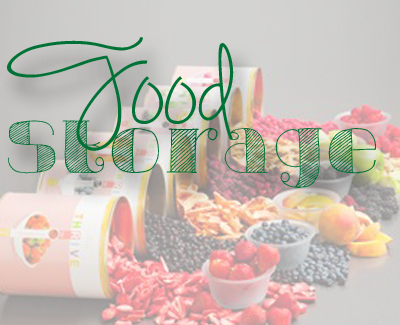Four Factors that affect food storage

While learning all the different methods for batch cooking, canning, preserving and pickling, and freezing, it is equally important to know how to store those foods after using these procedures and methods. There are four factors that affect food storage that you should be aware of when looking to gain optimum results for your efforts:
Temperature
Cooking food according to the recommended temperature is the safest way to ensure bacteria or other contaminants are not a subject of concern. Prior to cooking food, however, you need to be certain that the food you are buying is kept in a proper section of your market at the proper temperature. Before purchasing food, check the date on the label to ensure that it is not past its freshest due dates. Also, if you are purchasing a frozen item check to see that it is not semi-defrosted or too frozen, which may subject it to freezer burn.
Check your refrigerator and freezer for the appropriate recommended manufacturer setting and keep it at the highest setting recommended to avoid spoilage or over freezing.
Moisture
When canning foods especially, moisture comes into play. It is important to check your mason jars by either tapping it gently with a spoon or your finger to check and see if they have been sealed properly. If you press the top of the mason jar, you should be able to determine whether or not you have a proper seal. Moisture also comes into play when dehydrating foods. Salt curing will remove moisture from meats allowing the drying process to continue. Drying fruits and vegetables in the sun will remove moisture from them. Taking the fruits and vegetables in during moist evening hours will ensure that the fruits and vegetables can be dried further over the next couple of days.
Atmosphere
It is important to note that while canning, atmosphere comes into play for certain levels above sea level. Certain feet above sea level requires a change in how you can, the temperature at which you boil, and perhaps even the time allotment for boiling a particular food. Always check the recipe directions for instructions on same.
Containers
Freezing food for no longer than six months as a base, storing in proper food storage containers by sealing out air, and proper labeling are just some of the tips for keeping frozen foods safe and ready to use. Some containers are good for freezer to microwave (and sometimes, you can only get to know that if you read a convection microwave review of your microwave). While others can stain easily when sauce-based recipes are placed inside them. Always use a freezer marker to date items so that you can view the date you froze them with a quick glance.
Once you get the hang of freezing, canning, preserving, pickling, and drying out foods, the methods in which you store, temperatures for different recipes, and all the rules and regulations will become second nature. You will be well on your way to successful food preservation.



